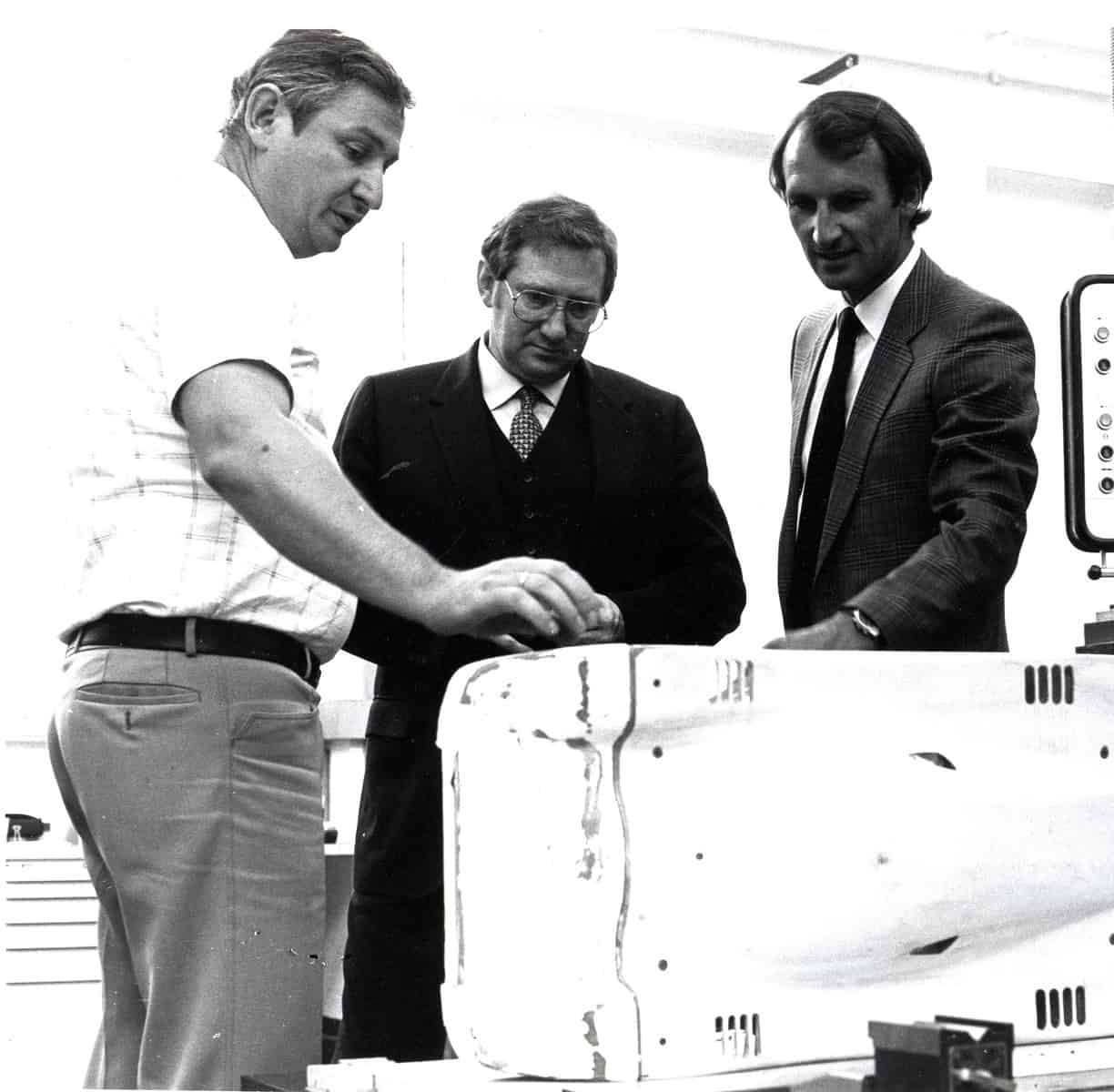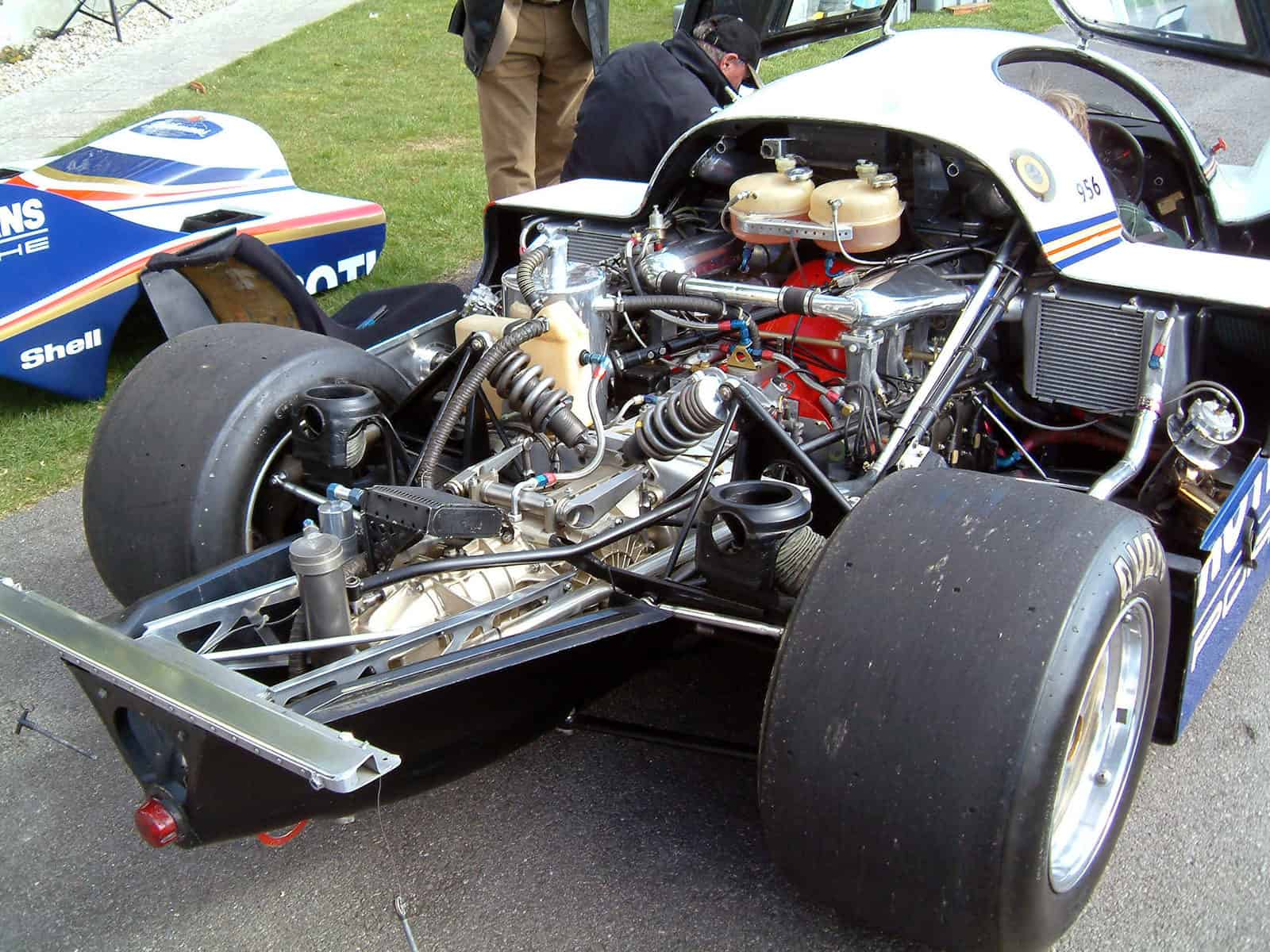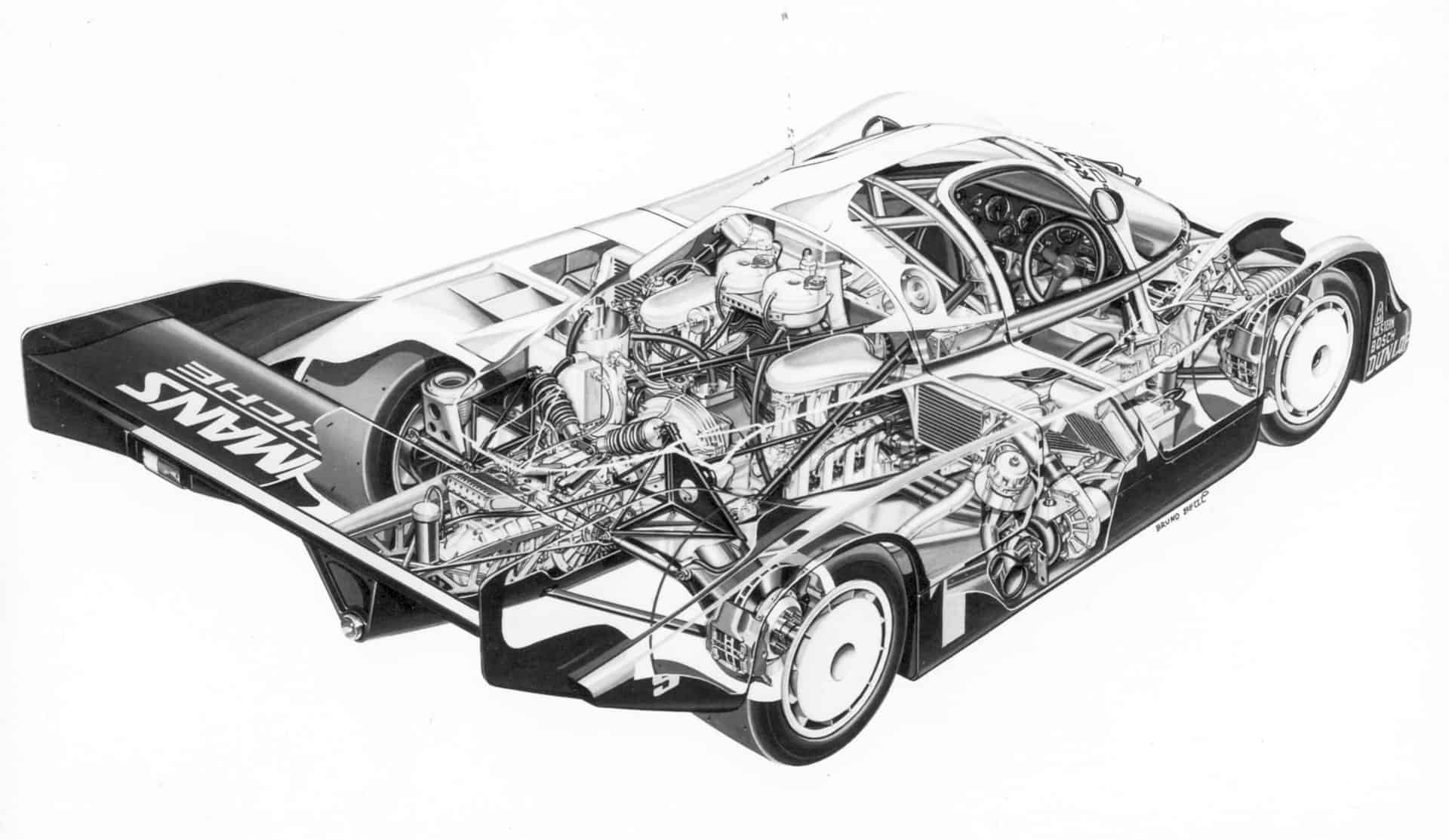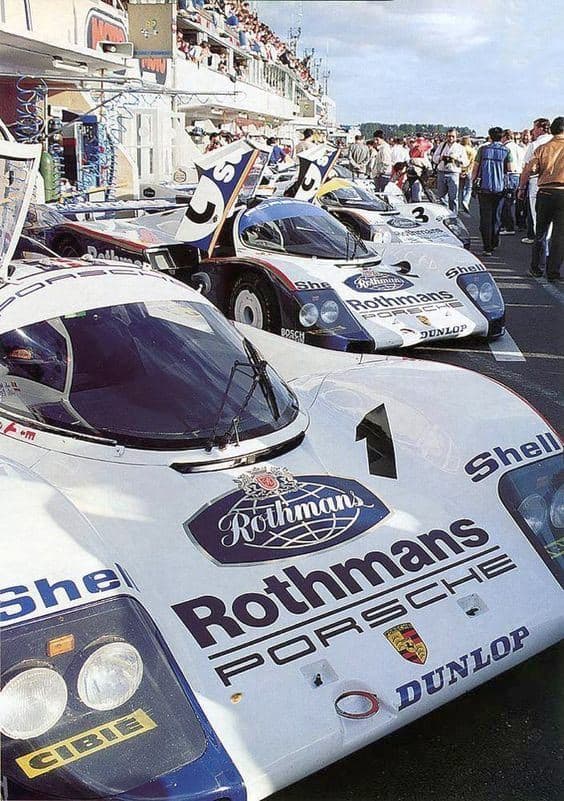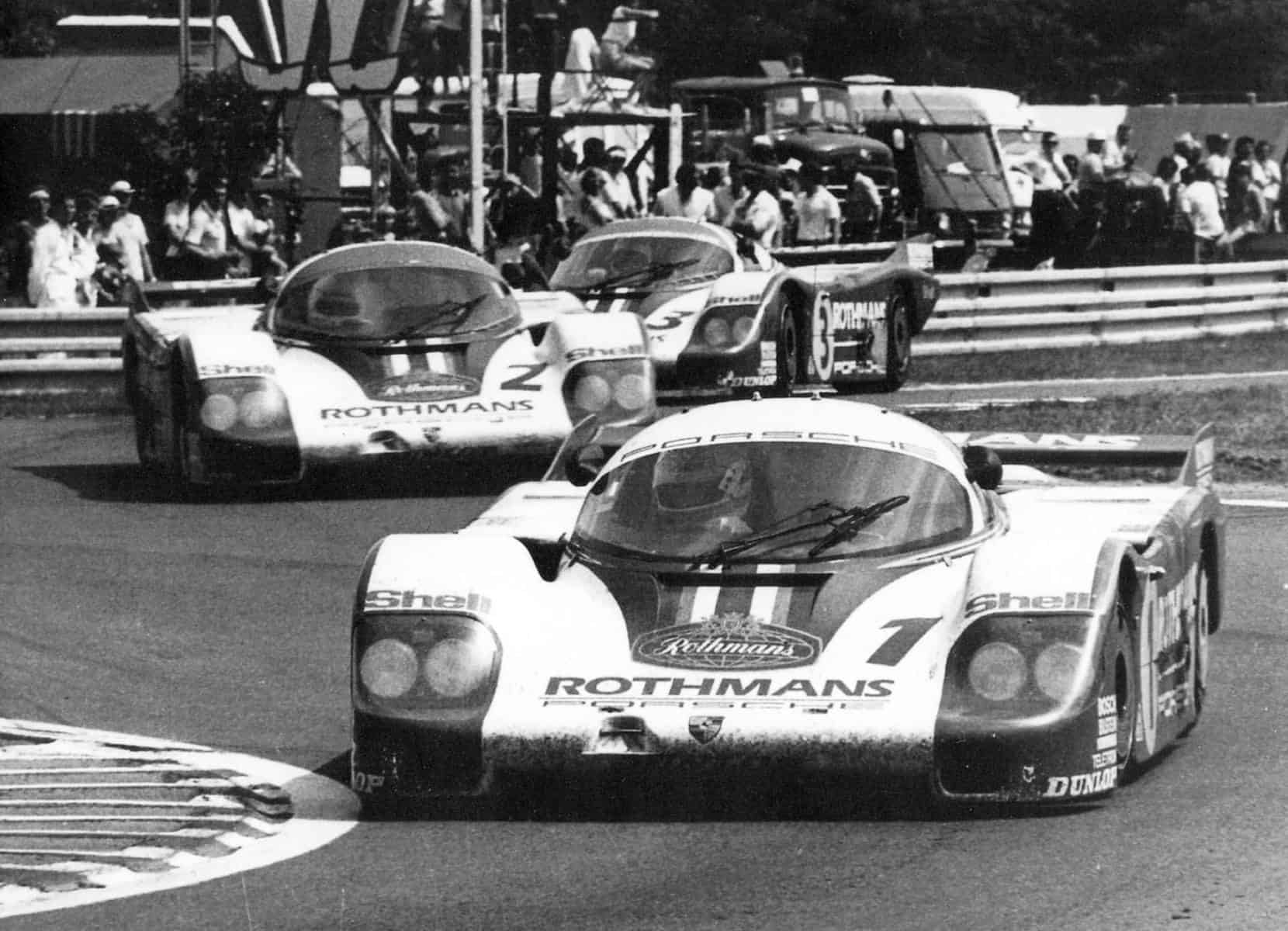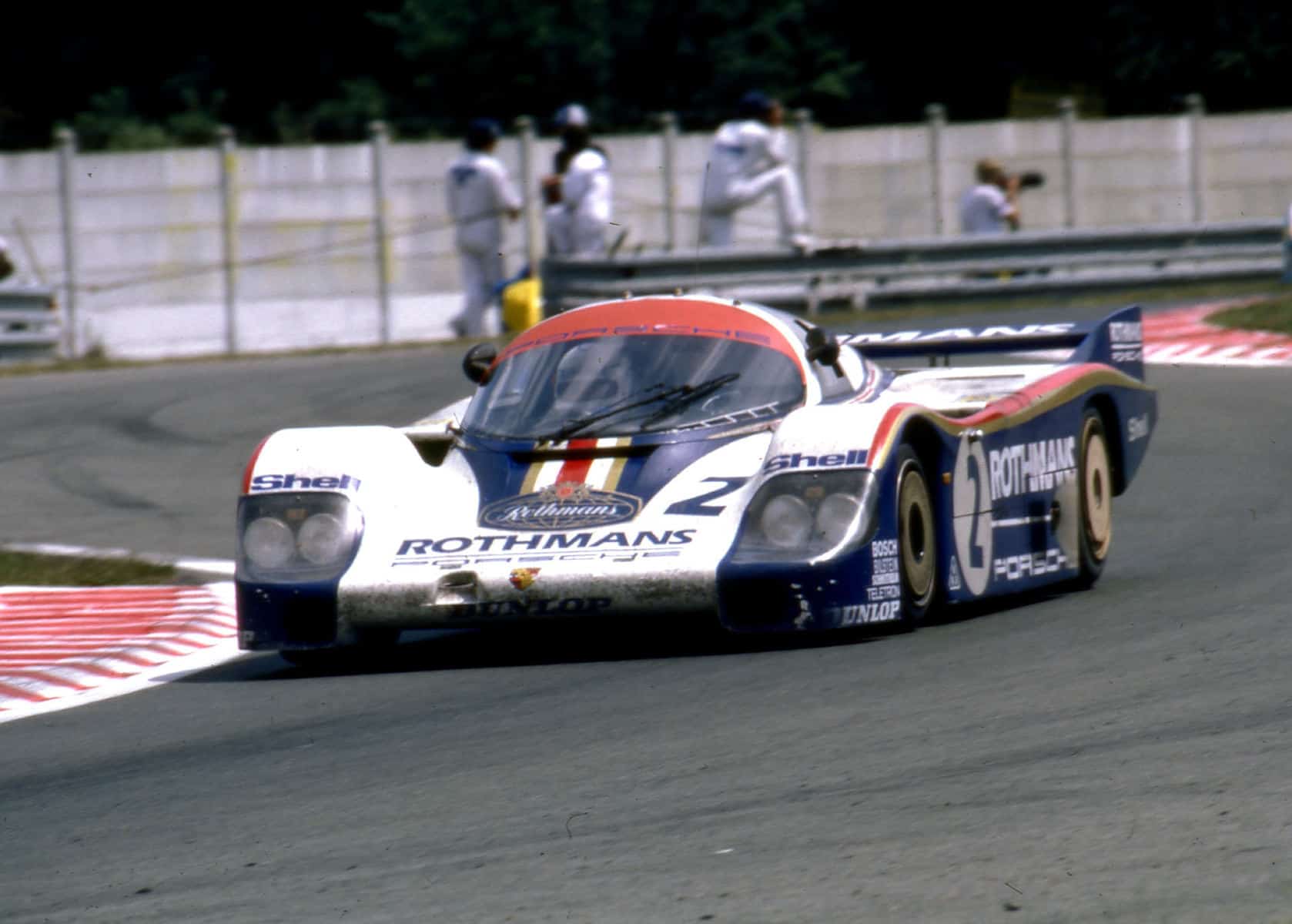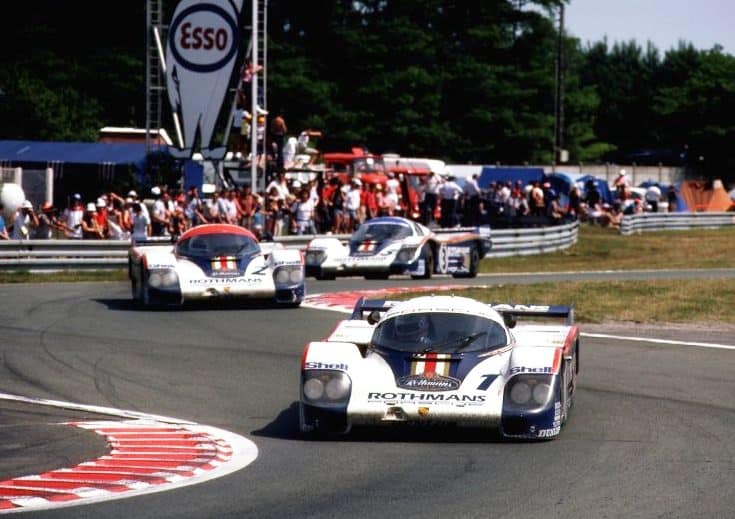Dream Debut for Porsche’s 956
The tale of Porsche’s first-ever monocoque racing car at Le Mans
BY: KARL LUDVIGSEN
PHOTOS: CLASSIC PORSCHE ARCHIVE
So much background, experience, and testing was invested in Porsche’s first-ever monocoque racing car that it swept its Group C category at Le Mans in 1982 – and the manner in which it did this astounded Porsche’s veteran racers.
“We made the booking five months and three days beforehand and knew we must pay if we didn’t make this date!” As expressed by Porsche engineer Norbert Singer, this was the eminently practical consideration that led to the first test of Porsche’s new Type 956 Group C racer on the Paul Ricard circuit near Marseilles on March 31, 1982.
This was a year and a quarter after the FISA racing authority had published its new rules for the World Endurance Championship in December of 1980. It would award points to both makes and drivers. Porsche was an obvious candidate for participation. Early in 1981 Porsche motor sports executive Jürgen Barth urged his chiefs “to consider preparations for a Porsche Group C project as quickly as possible.” Influential, too, was the news that the popular German Racing-Sports Championship, the DRM, would also adopt the new Group C rules.
Porsche proceeded to design, build, and test its Type 956, built around a 2.6-liter flat six of the same type that had won Le Mans in 1981. Twin-turbocharged, with four valves per cylinder in water-cooled, twin-cam heads, it produced 620 hp at 8,200 rpm. Turbocharging expert Valentin Schäffer was tasked with tuning it for best fuel economy. He was helped during 1982 by the adoption of Bosch’s Motronic electronic engine control, which at that early stage of its development cost $30,000 per copy.
Experienced racing engineer Norbert Singer directed wind-tunnel work that shaped the 956 body to excellent effect. “We achieved downforce that was almost twice as high as that of the legendary 917 Can-Am,” said Singer, “albeit in combination with a higher drag coefficient.” A special long-tail, low-drag version for Le Mans was developed as well. “In comparison to the famous long-tail 917 of 1971 its drag was four percent higher,” added Singer, “but the all-important downforce was three and a half times greater.”
This added downforce placed heavy stress on the 956’s suspension, patterned after that of the 936, and its frame. Hitherto Porsche had relied on tubular space frames. “We had much experience with space frames,” said Norbert Singer, “and we could make them strong and light. Also it would have been no problem to make good ground effects with a tubular frame.”
But Porsche created its first-ever monocoque frame for the 956 instead. “The reason for a monocoque was simple,” Singer continued. “The regulations for Group C asked for crushable structures to the front and for the sides, and this we could not do easily with tubes. There was also a good bonus in the stiffness of the monocoque against tubes.” Horst Reitter drew the aluminum-skinned monocoque that was at the heart of the 956.
Porsche faced a steep learning curve in making its first chassis tub. “We weren’t the first to make a monocoque—perhaps the last!” admitted Norbert Singer. “We looked into the aeronautical industry, looked at different methods. We learned that you need a high-copper aluminum alloy, which you can’t weld, so you need to rivet it and also use bonding. Then you have to put it in an oven to complete the bonding and stabilize it.”
March of 1982 was a crunch month for the Type 956. Le Mans was only three months away and none had yet turned a wheel. The first Group C race of the new season would be in mid-April and the next at Silverstone in mid-May. In March there was little thought of being ready for either of these; the focus was entirely on Le Mans. But if the car was judged ready, the fast Silverstone circuit would be a good test for Le Mans.
Norbert Singer wanted to get the full-size car into a wind tunnel to validate its aero characteristics, which he succeeded in doing at the big Volkswagen tunnel on 22 March. Then it was rushed back to Weissach for final touches. Finally on Saturday, 27 March, driver-tester Jürgen Barth suited up and stepped into the cockpit of 956 001 to turn its first laps on Weissach’s so-called Can-Am circuit, its fastest around the property’s periphery.
“We settled it on the springs, made sure which wing angles had to be used, and adjusted the brake balance,” said Norbert Singer. It was surprisingly satisfactory. In the course of this short shakedown a few faults were found and fixed—stronger shift linkage, altered oil catch tank and fuel-tank baffling, plus stronger support for the rear bodywork. Downforce was already exceeding expectation.
After this check drive the design team gathered as engineer Peter Falk popped open a bottle of champagne and christened 001. Then it was loaded up for its trip to the South of France. It made it to its date of destiny on the last day of Porsche’s booking. Again Barth undertook the test-driving duties. Sheer speed was not the objective; bogey times previously set by Porsche’s Group 6 936 were not bettered. But as a maiden run on a known circuit the outing was extremely promising.
According to Singer, “That first day of testing at Ricard made us all very proud because the car did 373 miles and was a brand-new car that you might think should be resting for a lot more time in the pits.” It required only such minor adjustments as the replacement of a big shift lever with a smaller one and a change of steering gear. “Four days after that,” Singer added, “Jacky Ickx and Jochen Mass started the tests at Ricard.” Bringing the total at Ricard to six hundred miles, their stints threw up a number of areas requiring attention.
Cooling arrangements were changed on the rear deck. Two separate NACA inlets replaced the single central air inlet for brake cooling air to give better flow. A new central duct fed air to a high-placed oil cooler for the transaxle. Instead of NACA ducts flanking the cabin to feed the main radiators, the tops of the doors were cut away so that air flowed around the cockpit and directly down into the radiators and intercoolers. This change responded to water-temperature readings that were 10-15 degrees C too high at Ricard.
Extensive alterations were made to tubing runs and fittings for the water, oil, and fuel systems. Gear-lever mounting was strengthened, throttle cable improved, fire-extinguisher piping under the dash moved to get more knee room, and shoulder belts shortened. A new type of pivot bearing was installed for the critical upper rear wishbones that actuated inboard springs. Changes were made to the turbo wastegates.
Then it was back to the tracks and testing for 956 001. April was a busy month. Tests concentrated on the cooling system during the week starting on 14 April. On 22 April it was subjected to stiffness analysis and on 23 April it began its mandatory session on the rough-road course at Weissach, the same track used to shake down production cars. This was “something that no other manufacturer of racing cars would dream of doing,” said Singer with understandable pride.
This test was no laughing matter, said Peter Falk at the time: “When you see the rough-road process taking place you cannot believe that they are torturing a circuit-racing car, for it is bouncing along like a Mark 2 Escort attacking three- to six-inch cobblestones!” The objective was to cover 1,000 kilometers of this punishment—621 miles. The only concession to the test was to raise the static ride height at all four corners.
Testing began on the 1.8-mile rough road at 11:35 a.m. in dry conditions with two drivers on hand: mechanic Hubert Mimler—whose test driving dated back to the Formula One years of 1961-62—and Jacky Ickx. Covering 137 miles that day, they stopped twice for repairs to the shift linkage and suspension and ended the run when a tooth broke on the aluminum steering rack.
Ickx had the pleasure of covering eighty-nine miles the next day in snow and rain. During the day the upper-left-rear bell crank to the spring broke, so it was replaced with the strengthened version. When the run was interrupted to make body changes for wind-tunnel tests the steering had developed play at its center.
On 26 April tests resumed at 12:30 p.m. in better weather with a new steering rack; Mimler drove first, followed by engineer Roland Kussmaul. In all they completed ninety-one miles. They deliberately ran the fuel tank dry, switching on the reserve pump when the warning light came on and the engine started missing. The 956 covered another 12.5 miles before stopping. When refilled the tank took 106.5 liters; Porsche would later pack its housing to the legal 100-liter volume. Before the run was ended at 2:30 p.m., a weld in the roll cage had broken and another steering-rack tooth had fractured.
The tests were interrupted for another trip to the VW wind tunnel for full-scale tests of the final body revisions for Le Mans and then a session at Paul Ricard to establish the suspension and wing settings for the special Le Mans bodywork. When the rough-road test resumed on 6 May at 11:15 a.m. Roland Kussmaul was at the helm of a 956 001 that had been upgraded in light of the earlier test findings. One hundred and eight miles were covered, bringing the total to 426 miles before the endurance test was ended with a breakage of one of the mounts for the nosepiece and, again, lost motion in the steering.
At this point, including the testing at Ricard and all the laps on all the roads at Weissach, 956 001 had covered a remarkable 4,244 miles. But it still had miles to cover because Porsche had entered it—freshly Rothmans-liveried—to race at Silverstone on 16 May, crewed by its star pairing of Jacky Ickx and Derek Bell.
This race posed a special challenge because it was to be run to a six-hour duration on this very fast track, which could see some 1,100 kilometers covered instead of the 1,000 kilometers for which five refuelings were permitted. Fuel economy was intended to be a severe test for the Group C runners.
Fuel mileage was not an issue for two cheeky entries in the 1982 season—LC1 Barchettas built by Dallara for Lancia. These took advantage of a provision of the rules in this first Group C season that allowed old Group 5 and 6 cars to continue competing to fill out the fields. They were allowed to race for driver points but not maker points. Audaciously, Lancia’s Cesare Fiorio decided to build two new turbocharged 1.4-liter Group 6 roadsters and crew them with a talented all-Italian team. Just to rub it in they were sponsored by longtime Porsche partner Martini & Rossi.
The Lancia LC1 driven by Riccardo Patrese and Michele Alboreto won by three laps at Silverstone. Second, however, was the 956. Peter Falk had sought, in vain, to persuade the organizers to adopt a more fuel-friendly race distance. Faced with an economy run he used the practice period to try out low boosts, lean mixtures, and higher gearing to stretch the mileage. However, Jacky Ickx was given free rein, full boost, and a set of sticky Dunlop tires to set the fastest qualifying lap with a time three seconds better than the Silverstone sports-car record, previously held by Jochen Mass in the 956’s direct ancestor, the 936. The new record speed was a heady 137.241 mph.
Settling for second overall and first in Group C on the 956’s debut was no hardship. The fuel mileage achieved was 49.6 l/100 km, which gave Porsche confidence that it could cope with any challenges on this front. The next race, at the Nürburgring on 30 May, was always an important venue for Zuffenhausen. However, Porsche elected to sit this out to complete its Le Mans preparations—a clear indication of the priority it awarded to the French race, for which it was building three additional cars.
The next labor of Hercules for 956 001 was tackling the chassis dynamometer at Weissach. They tethered the car with its rear wheels on large-diameter, electrically braked rollers of the dynamometer in Porsche’s climatic wind tunnel. A massive iron weight on the rear of the chassis maintained traction of the specially made Dunlop tires, so hard they were nicknamed Betonmischung or “concrete compound.” Huge blowers at the front pumped air through hoses to the side inlets, effectively blocking any exit from the car for the test driver. “It was especially dangerous for the driver,” recalled Peter Falk, who took turns on the rollers. “Had there been a fire it would have been hard for him to get out!”
It was the driver’s task to “race” the 956 on lap after lap of the Le Mans circuit, following a simplified version of its running pattern that validated the reliability of the drive line under Le Mans conditions. “It was unbelievably loud and hot inside,” said Falk. “We shifted up through the gears, then held it at full throttle—around 7,800 rpm—for a minute, then braked down to first, then up to speed again for a minute to represent the straight. When it lasted thirty hours on the chassis dyno, we could finish Le Mans.” This grueling test was endured by the new 956, and passed, on 21–22 May.
Now Porsche knew as much as it was likely to about the strengths and weaknesses of its new car. Of the former there were many and of the latter few. It remained only to build chassis 002 through 004 and ready them for Le Mans, which began on 19 June. “On 11 June,” recalled Norbert Singer, “about a week before the race, two of the three entries were ready to be test driven at Weissach and thereafter to be loaded up for the race. The third was completed on the fourteenth.
“The result of this most difficult long-distance race was astonishing even for the most optimistic,” Singer added. “After twenty-four hours the result corresponded to the numbers of the cars. Three cars at the start and those three the first overall at the finish—who would have thought it? Thus began the unique and spectacular success story of this car.”
The speed was there as Jacky Ickx demonstrated on Wednesday with a pole-setting lap at 146.265 mph, a second faster than his best practice lap the prior year in the 936/81. In a sister car Jochen Mass also improved on the previous year’s best time. The engine of the Ickx/Bell car was changed when the original showed a loss of compression during practice. Vern Schuppan’s 956 veered ominously on the straight when a rear tire was punctured on Thursday, but he kept it away from the barriers. Damage to its suspension from the tire’s remains was severe enough to require extensive repairs on Friday.
Settling for second overall and first in Group C on the 956’s debut was no hardship. The fuel mileage achieved was 49.6 l/100 km, which gave Porsche confidence that it could cope with any challenges on this front. The next race, at the Nürburgring on 30 May, was always an important venue for Zuffenhausen. However, Porsche elected to sit this out to complete its Le Mans preparations—a clear indication of the priority it awarded to the French race, for which it was building three additional cars.
The next labor of Hercules for 956 001 was tackling the chassis dynamometer at Weissach. They tethered the car with its rear wheels on large-diameter, electrically braked rollers of the dynamometer in Porsche’s climatic wind tunnel. A massive iron weight on the rear of the chassis maintained traction of the specially made Dunlop tires, so hard they were nicknamed Betonmischung or “concrete compound.” Huge blowers at the front pumped air through hoses to the side inlets, effectively blocking any exit from the car for the test driver. “It was especially dangerous for the driver,” recalled Peter Falk, who took turns on the rollers. “Had there been a fire it would have been hard for him to get out!”
Practice showed that fuel consumption could be a concern so Porsche was hoping that its Ford-Cosworth-powered Group C rivals—Fords, Saubers, Rondeaus, Lolas—would suffer problems. This they duly did, expiring from failures caused by the severe vibration of their 3.9-liter DFL engines. Porsche was able to conserve fuel so well that the winning Ickx/Bell car (956 002) averaged 47.7 l/100 km. “The winning car had a minor problem,” reported Singer, “misfiring for a while, so we changed the fuel mixture twice. We changed the pads after thirteen hours and dealt with a puncture after seventeen hours. And that was all.”
Three laps behind was 956 003 of Jochen Mass and Vern Schuppan, averaging 48.9 l/100 km. Al Holbert, Hurley Haywood, and Jürgen Barth in 956 004 finished third, nineteen laps off the leader’s pace. This was the Pechvogel (unlucky bird) of the trio, having suffered the loss of an ill-latched door that was ripped away by the air stream. It borrowed a door from 956 001, on hand as a spare. It also failed a right-rear hub seal, losing lubricant and suffering bearing damage that took almost half an hour to repair. The second-place finisher lost some brake fluid from a split pipe.
Surveying the depleted pit apron at midday on Sunday, Helmuth Bott said, “Too many people have come here with untested equipment.” This was not a criticism that could be laid at Porsche’s door. That year Porsches not only swept the first three Group C places at Le Mans but also won IMSA GTX and GTO, Grand Touring, and Group 5. There were no other categories to be won. Even the Index of Efficiency, a Le Mans prize that related a number of performance factors and was usually captured by a small car, was captured by the Ickx/Bell 956.
Many Porsche racing men would look back on Le Mans 1982 as a high point of achievement. Journalist Jeremy Walton’s comment on their success deserves quoting: “Porsche is not invincible and the engineering side of the company would never try to sell you such a myth, but it is the nearest thing man has produced to perfection in long-distance racing.”
“We could tell even then that the 956 was going to change the rules of sports-car racing,” said Derek Bell. “It had full ground effect and was electrifyingly quick on the track.” Though Porsche hadn’t planned to enter all the remaining series events of 1982, it did so, winning at Spa, Fuji, and Brands Hatch to annex the World Championship for Makes. By 1986 the 956 had won twenty-seven races, qualifying for makes’ and drivers’ championships. It was on its way to well-deserved legendary status.


